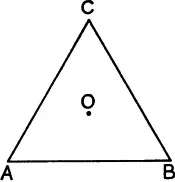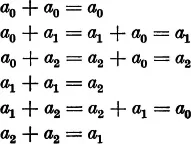
eBook - ePub
An Introduction to the Theory of Groups
- 128 pages
- English
- ePUB (mobile friendly)
- Available on iOS & Android
eBook - ePub
An Introduction to the Theory of Groups
About this book
This introductory exposition of group theory by an eminent Russian mathematician is particularly suited to undergraduates, developing material of fundamental importance in a clear and rigorous fashion. The treatment is also useful as a review for more advanced students with some background in group theory.
Beginning with introductory examples of the group concept, the text advances to considerations of groups of permutations, isomorphism, cyclic subgroups, simple groups of movements, invariant subgroups, and partitioning of groups. An appendix provides elementary concepts from set theory. A wealth of simple examples, primarily geometrical, illustrate the primary concepts. Exercises at the end of each chapter provide additional reinforcement.
Beginning with introductory examples of the group concept, the text advances to considerations of groups of permutations, isomorphism, cyclic subgroups, simple groups of movements, invariant subgroups, and partitioning of groups. An appendix provides elementary concepts from set theory. A wealth of simple examples, primarily geometrical, illustrate the primary concepts. Exercises at the end of each chapter provide additional reinforcement.
Frequently asked questions
Yes, you can cancel anytime from the Subscription tab in your account settings on the Perlego website. Your subscription will stay active until the end of your current billing period. Learn how to cancel your subscription.
No, books cannot be downloaded as external files, such as PDFs, for use outside of Perlego. However, you can download books within the Perlego app for offline reading on mobile or tablet. Learn more here.
Perlego offers two plans: Essential and Complete
- Essential is ideal for learners and professionals who enjoy exploring a wide range of subjects. Access the Essential Library with 800,000+ trusted titles and best-sellers across business, personal growth, and the humanities. Includes unlimited reading time and Standard Read Aloud voice.
- Complete: Perfect for advanced learners and researchers needing full, unrestricted access. Unlock 1.4M+ books across hundreds of subjects, including academic and specialized titles. The Complete Plan also includes advanced features like Premium Read Aloud and Research Assistant.
We are an online textbook subscription service, where you can get access to an entire online library for less than the price of a single book per month. With over 1 million books across 1000+ topics, we’ve got you covered! Learn more here.
Look out for the read-aloud symbol on your next book to see if you can listen to it. The read-aloud tool reads text aloud for you, highlighting the text as it is being read. You can pause it, speed it up and slow it down. Learn more here.
Yes! You can use the Perlego app on both iOS or Android devices to read anytime, anywhere — even offline. Perfect for commutes or when you’re on the go.
Please note we cannot support devices running on iOS 13 and Android 7 or earlier. Learn more about using the app.
Please note we cannot support devices running on iOS 13 and Android 7 or earlier. Learn more about using the app.
Yes, you can access An Introduction to the Theory of Groups by Paul Alexandroff, Hazel Perfect, Hazel Perfect,G.M. Petersen in PDF and/or ePUB format, as well as other popular books in Mathematics & Group Theory. We have over one million books available in our catalogue for you to explore.
Information
Chapter I
THE GROUP CONCEPT
§ 1. Introductory examples
1. Operations with whole numbers
The addition of whole numbers * satisfies the following conditions, which we call axioms of addition and which are of very great importance for all that follows:
I. Two numbers can be added together (i.e. to any two arbitrary numbers a and b there corresponds a uniquely determined number, which we call their sum: a + b).
II. The Associative Law:
For any three arbitrary numbers a, b, c we have the following identity

III. Among the numbers there is a uniquely determined number 0, the zero, which is such that for every number a the relation

is satisfied.
IV. To every number a there corresponds a so-called inverse (or negative) number —a, which has the property that the sum a + (—a) is equal to zero:

Finally yet another important condition is satisfied.
V. The Commutative Law:

2. The rotations of an equilateral triangle
We show that it is possible to add not only numbers but also many other kinds of things, and that the above conditions remain satisfied.
First Example.—We consider all possible rotations of an equilateral triangle ABC about its centroid 0 (fig. 1). We agree to call two rotations identical if they only differ from one another by a whole number of complete revolutions (and therefore by an integral multiple of 360°*). We see without difficulty that of all possible rotations of the triangle only three rotations send it into coincidence with itself, namely, the rotations through 120°, 240°, and the so-called zero rotation, which leaves all the vertices unchanged and hence also all the sides of the triangle. The first rotation sends the vertex A into the vertex B, the vertex B into the vertex C, the vertex C into the vertex A (we say that it permutes cyclically the vertices A, B, C). The second rotation sends A into C, B into A, C into B, and therefore permutes A,C,B cyclically.

Fig. 1
Now we introduce the following natural definition: The addition of two rotations means their successive application, the first rotation followed by the second. If we add the rotation through 120° to itself, then the result is the rotation through 240°; if we add to it the rotation through 240°, then the result is the rotation through 360°, the zero rotation. Two rotations through 240° result in the rotation through 480° = 360° + 120°; their sum is therefore the rotation through 120°. If we denote the zero rotation by a0, the rotation through 120° by a1, the rotation through 240° by a2, then we obtain the following relations:

Thus the sum of any two of the rotations a0, a1, a2 is defined and is again one of the rotations a0, a1, a2 We easily convince ourselves that this addition satisfies the associative law and evidently also the commutative law. Further, there exists among these rotations a0, a1, a2 a zero rotation a0 which satisfies the...
Table of contents
- Cover Page
- Title Page
- Copyright Page
- Translators’ Foreword
- from the Foreword to the First Edition
- Contents
- CHAPTER ONE. THE GROUP CONCEPT
- CHAPTER TWO. GROUPS OF PERMUTATIONS
- CHAPTER THREE. SOME GENERAL REMARKS ABOUT GROUPS. THE CONCEPT OF ISOMORPHISM
- CHAPTER FOUR. CYCLIC SUBGROUPS OF A GIVEN GROUP
- CHAPTER FIVE. SIMPLE GROUPS OF MOVEMENTS
- CHAPTER SIX. INVARIANT SUBGROUPS
- CHAPTER SEVEN. HOMOMORPHIC MAPPINGS
- CHAPTER EIGHT. PARTITIONING OF A GROUP RELATIVE TO A GIVEN SUBGROUP. DIFFERENCE MODULES
- APPENDIX. ELEMENTARY CONCEPTS FROM THE THEORY OF SETS
- BOOKS TO CONSULT
- INDEX
- Back Cover